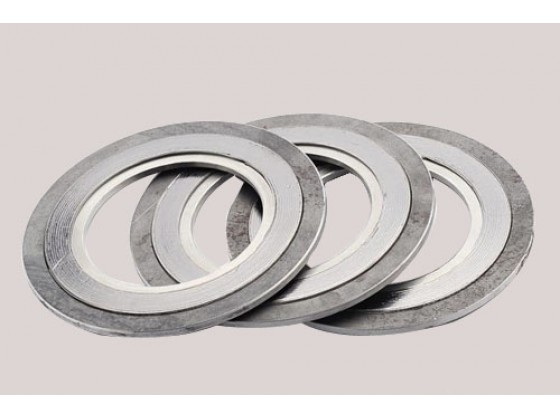Metal wound gaskets are the most widely used and reliable sealing solution for industrial piping and equipment flanges. Their unique, mature structure delivers exceptional sealing performance under high temperature, high pressure, and cyclic conditions, making them indispensable in power generation, petrochemical, and chemical industries.
1. Structure Analysis: Hybrid Rigid-Flexible Composite
The core structure consists of alternating spiral layers of metal strip and non-metallic filler material, typically reinforced with inner/outer rings (Figure 1):
Figure 1: Metal Wound Gasket Structure
https://via.placeholder.com/450×250.png?text=Metal+Wound+Gasket+Structure
(Illustration: V-shaped metal strip + filler material spiral winding with inner/outer rings)
Key Components:
- Sealing Core:
- V/W-Shaped Metal Strip (0.15–0.25 mm thick): Stainless steel (304/316) or specialty alloys (Inconel®). Provides elastic recovery and mechanical strength.
- Non-Metallic Filler: Graphite, PTFE, mica, or ceramic fibers embedded in metal strip grooves. Ensures initial sealing and compensates for micro-imperfections.
- Winding Process: Metal/filler strips wound at ≈30° to form concentric sealing layers.
- Reinforcement Rings:
- Inner Ring: Solid metal (carbon/stainless steel). Prevents inward gasket relaxation, resists blowout, and aids centering.
- Outer Ring: Identical material. Protects edges, limits outward relaxation, and distributes bolt load.
2. Structural Advantages: Superior Sealing Performance
- Elastic Compensation: Multilayered thin strips + soft filler accommodate flange warping, vibration, and bolt-load variations.
- Extreme T/P Resistance: Metal strips withstand bolt load/internal pressure; graphite/mica maintain stability at ≤1,000°C.
- Stress Distribution & Anti-Relaxation: Spiral winding disperses compressive stress; V/W geometry provides spring-like rebound during thermal cycles.
- Blowout Resistance: Inner/outer rings + rigid structure prevent high-pressure ejection.
- Wide Adaptability: Customizable materials/designs suit temperatures (-200°C to +1,000°C+), pressures (vacuum to 500+ bar), and media (acids, H₂, steam).
3. Comparison with Other Flange Gaskets
Table 1: Metal Wound Gasket vs. Alternatives
| Property | Metal Wound | Rubber/Composite | PTFE Gasket | Metal Jacketed | Serrated Metal |
|---|---|---|---|---|---|
| Max. Temp. | -200°C to 1,000°C+ | -40°C to 150°C | -200°C to 260°C* | -200°C to 800°C+ | -200°C to 1,000°C+ |
| Max. Pressure | <img width=150/>500+ bar | 40–80 bar | 60–100 bar | 300+ bar | 500+ bar |
| Thermal Cycling | Excellent | Poor (aging) | Poor (cold flow) | Moderate | Poor (non-recoverable) |
| Chemical Resistance | Wide (material-dependent) | Limited (rubber type) | Excellent (PTFE inert) | Wide | Wide |
| Flange Face Finish | RF (Ra 3.2–6.3 μm) | Low roughness tolerance | Smooth (anti-extrusion) | Mirror finish required | RTJ groove required |
| Cost/Reusability | High cost; single-use | Low cost; reusable | Moderate; limited reuse | High; single-use | High; single-use |
| *Avoid severe thermal shock. |
4. Key Materials & Applications
Metal Strip Selection:
- SS 304/304L: General industrial use (-200°C–550°C; steam, oil, weak acids).
- SS 316/316L: Superior chloride resistance (e.g., seawater, acetic acid).
- Inconel® 625/X750: Extreme conditions (+1,000°C, H₂, sour gas, nuclear).
- Monel® 400: HF acid, hot alkalis, marine.
- Titanium: Aerospace, chlor-alkali.
Filler Materials:
- Flexible Graphite:
- Pros: -200°C–1,600°C (inert atm); chemical resistance; self-lubricating.
- Cons: Unsuitable for strong oxidizers (HNO₃).
- Use: Primary choice for steam, H₂, ammonia, thermal oil (≥90% of HT/HP apps).
- PTFE:
- Pros: Universal chemical resistance; low friction.
- Cons: Severe cold flow (>100°C/20 bar); thermal expansion.
- Use: Pharma/food; acids/alkalis <200°C.
- Mica: High temp insulation; electrochemical corrosion resistance.
- Ceramic Fiber: Eco-friendly; moderate temp (≤1,000°C).
Conclusion
Metal wound gaskets dominate critical flange sealing by merging metal strength with filler compressibility. Despite higher cost, non-reusability, and stringent flange finish requirements (RF preferred), their reliability under thermal cycling/pressure surges is unmatched. Material flexibility enables tailored solutions per ASME B16.20/EN 1514. Selection requires rigorous validation of temperature, pressure, medium, and cyclic loads.
Post time: Aug-05-2025

